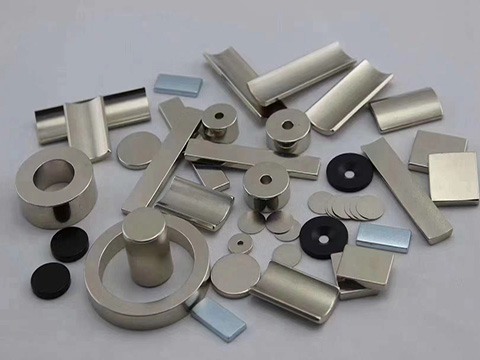
What Are Neodymium Magnets? Frequently asked Questions about NdFeB
Do you know what is an NdFeB magnet? This article will summarize the frequently asked questions about NdFeB, hoping to help you understand the basic knowledge of NdFeB magnets?
What is ndfeb magnet? How are ndfeb magnets made? How to magnetize ndfeb magnets? What is the density of a ndfeb magnet? What temp ndfeb magets lose magnetism? Which neodymium magnet is the strongest? Why neodymium magnets are so strong? Where neodymium magnets are used? Are neodymium magnets safe? |
What is ndfeb magnet?
NdFeB magnets, also known as neodymium magnets, are the strongest permanent magnets made from an alloy of neodymium, iron, and boron. They have a high resistance to demagnetization and can retain their magnetism even when exposed to high temperatures. NdFeB magnets are commonly used in various industries, such as electronics, automotive, healthcare, and renewable energy, due to their exceptional strength and durability.

How are ndfeb magnets made?
NdFeB (neodymium iron boron) magnets are made using a process called sintering, which involves the following steps:
Raw materials: The first step in the process is to gather the raw materials for the magnets, which typically include neodymium, iron, and boron, along with other elements like dysprosium and praseodymium.
Melting: The raw materials are melted down in a furnace to create a molten metal mixture.
Milling: The molten metal is then cooled and solidified into small particles or powder, which are then milled to create a fine, uniform mixture.
Pressing: The milled mixture is pressed into a mold to create a green body, which is a rough shape of the magnet.
Sintering: The green body is then sintered in a high-temperature furnace for several hours, during which time the particles fuse together, creating a solid magnet.
Machining: After sintering, the magnet is machined to the desired shape and size.
Plating/coating: Finally, the magnet is coated or plated with a protective material to prevent oxidation and improve durability.
The end result is a high-strength, permanent magnet that is used in a wide range of applications, from motors and generators to medical equipment and consumer electronics.
How to magnetize ndfeb magnets?
Choose the appropriate magnetizing device: There are two main types of devices that can be used to magnetize NdFeB magnets – Pulse Magnetizers and Continuous magnetizers. Pulse magnetizers are commonly used for small and medium-sized magnets, while Continuous magnetizers are suitable for large and thick NdFeB magnets.
Prepare the magnetizing device: Before using the magnetizing device, ensure that it is clean and free from any debris or contaminants that can affect the magnetizing process. Adjust the device based on the size and shape of the magnet.
Align the NdFeB magnet properly: The magnet should be aligned in the right direction in relation to the magnetic field of the device. Use non-magnetic materials like plastic or wood to hold the magnet in place.
Magnetization process: Turn on the magnetizing device and allow the magnetic field to penetrate the NdFeB magnet. The length of time required for magnetization depends on the strength of the magnetic field and the size of the magnet.
Verify the magnetization: After the magnetization process, test the NdFeB magnet by using a gaussmeter to confirm the polarity and strength of the magnetic field.
Store the NdFeB magnet properly: Once the magnetization process is complete, store the NdFeB magnet in a safe and dry place to avoid demagnetization due to exposure to other magnetic fields or high temperatures.
What is the density of a ndfeb magnet?
The density of a neodymium magnet (NdFeB) is approximately 7.5-7.6 grams per cubic centimeter.
What temp ndfeb magets lose magnetism?
The temperature at which NdFeB magnets begin to lose magnetism varies depending on the specific grade or composition of the magnet. Generally, NdFeB magnets begin to lose magnetism at temperatures above 80-100 degrees Celsius (176-212 degrees Fahrenheit). However, higher grade magnets can withstand temperatures up to 200-220 degrees Celsius (392-428 degrees Fahrenheit) before experiencing significant demagnetization. It is important to consult the manufacturer's specifications for specific temperature limits for a particular NdFeB magnet.
Which neodymium magnet is the strongest?
The strongest neodymium magnet available is the N52 grade magnet. It has a strength rating of over 50 MGOe (Mega Gauss Oersteds) and is the highest grade neodymium magnet available commercially.
Why neodymium magnets are so strong?
Neodymium magnets are so strong because of the unique molecular structure of the neodymium material. These magnets are made from an alloy of neodymium, iron, and boron (Nd2Fe14B), which has a crystal structure called a tetragonal crystalline structure. This structure allows for strong and consistent magnetic fields to be generated. Additionally, neodymium magnets have a high magnetization value and high coercivity, meaning they can generate strong magnetic fields and maintain those fields in the presence of external magnetic fields. These factors result in neodymium magnets being among the strongest permanent magnets commercially available.
Where neodymium magnets are used?
Neodymium magnets are used in a variety of applications, including:
Electric motors and generators
Loudspeakers and headphones
Magnetic resonance imaging (MRI) machines
Magnetic levitation (maglev) trains
Wind turbines
Hard disk drives and other computer components
Magnetic toys and games
Metal detectors
Magnetic closures in jewelry and handbags
Holding and lifting systems in manufacturing and construction industries.
Are neodymium magnets safe?
According to experts, neodymium magnets can be safe when handled properly. However, care should be taken because they are extremely strong and can pose a danger if not handled with caution. Swallowing multiple magnets can cause severe digestive issues, and larger magnets can be dangerous if ingested. It is essential to keep neodymium magnets away from young children and pets as ingesting these magnets can be fatal. Additionally, people with pacemakers or other electronic medical devices should avoid getting too close to these magnets as they can interfere with the functioning of the medical device. If in doubt, it is always better to seek advice from qualified experts.
